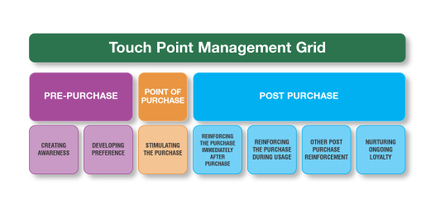From time to time we are asked to help make the brand promise real at each point of customer contact. To achieve this we begin with a highly facilitated full-day ideation session, which is designed to generate a large number of ideas to reinforce the brand essence, promise and personality at the specified customer touchpoint(s).
A wide variety of ideation techniques are used in this session. This is followed by a two to four hour meeting with a smaller group of people to sift through and evaluate the ideas generated in the ideation session and to identify and build upon the most promising ones. It is important to develop criteria for selecting the ideas with the highest potential for the least cost and effort. Specifically, customer touchpoint design includes the following:
•Identifying each major point of customer contact
•Choosing the first point of contact on which to focus
•Ideating new brand ‘proof points’ or experiences for that point of customer contact
•Developing and applying appropriate criteria to this selection process
•Identifying the most promising (ROI) set of customer touchpoint experiences generated in the ideation session
•Selecting 2 to 4 of the most promising ideas
•More fully developing those ideas
•Developing plans to implement the top ideas
This process can also include:
•Ideating potential new points of customer contact
•Identifying customer problem areas at each point of contact and ideating solutions to those problems
Customer touchpoint design can be augmented with two other customer touchpoint reengineering processes:
•Customer Process Blueprinting, in which each customer process in question is flow-charted to identify potential flaws or problems areas. The steps include the following:
-Map connections between front line employee actions, back office support person actions, supporting systems and processes and the customer experience
-Identify places in the process that have the potential to significantly increase customer satisfaction and places that can detract from the donor experience
-Identify and take corrective action as appropriate
•Breaking Customer Compromises session, comprised of customer focus groups to identify the ‘ideal state’ (product/service purchase, usage, and support) through guided imagery exercises followed by ideation sessions to identify ways to close the gaps between the ‘ideal state’ and current industry/organization conventions and assumptions about the way things are
•[From a 1996 Harvard Business Review article: “The best way to create breakaway business growth is to identify all the ways in which a business has made compromises with the customer and then break them all so that that customer gets exactly what he needs and wants.”]
•Steps:
oIdentify ‘compromises,’ that if ‘broken’ can provide huge increases in customer satisfaction and loyalty (potentially transforming the brand into a strong ‘category of one’)
Conduct customer focus groups – highly specialized technique to help people imagine the ‘ideal’ (independent of the current state)
-Identify gaps between ideal envisioned state and current state
-Identify gaps that, if filled, have the potential to deliver the greatest ROI
-Ideate approaches to close the gaps
(internal facilitated ideation session(s))
This simplified touchpoint management grid brings the process closer:
(click for larger view)
Simply put, Customer Touchpoint Design maximizes customer insistence for your brand.
Branding Strategy Insider is a service of The Blake Project: A strategic brand consultancy specializing in Brand Research, Brand Strategy, Brand Licensing and Brand Education


